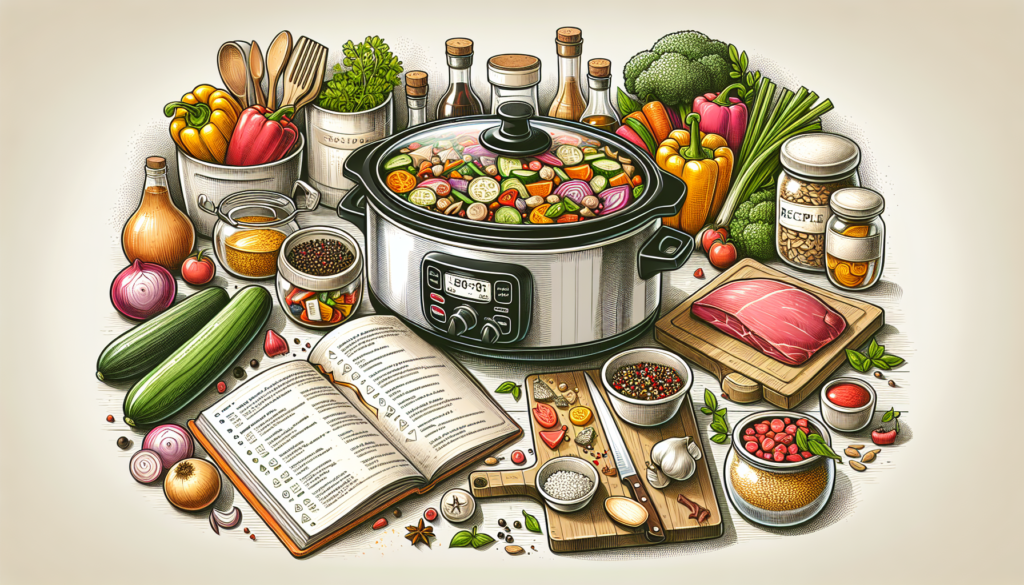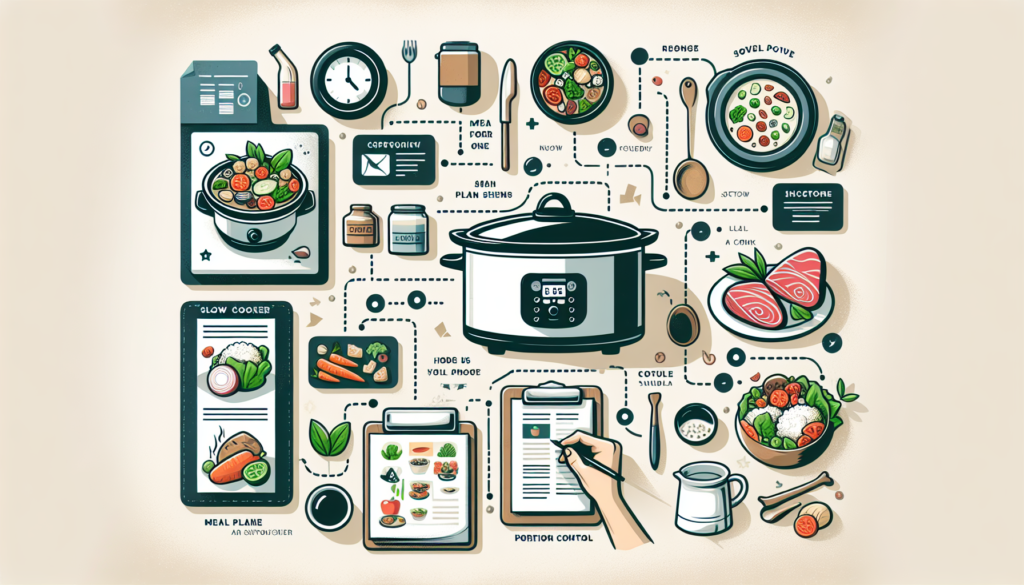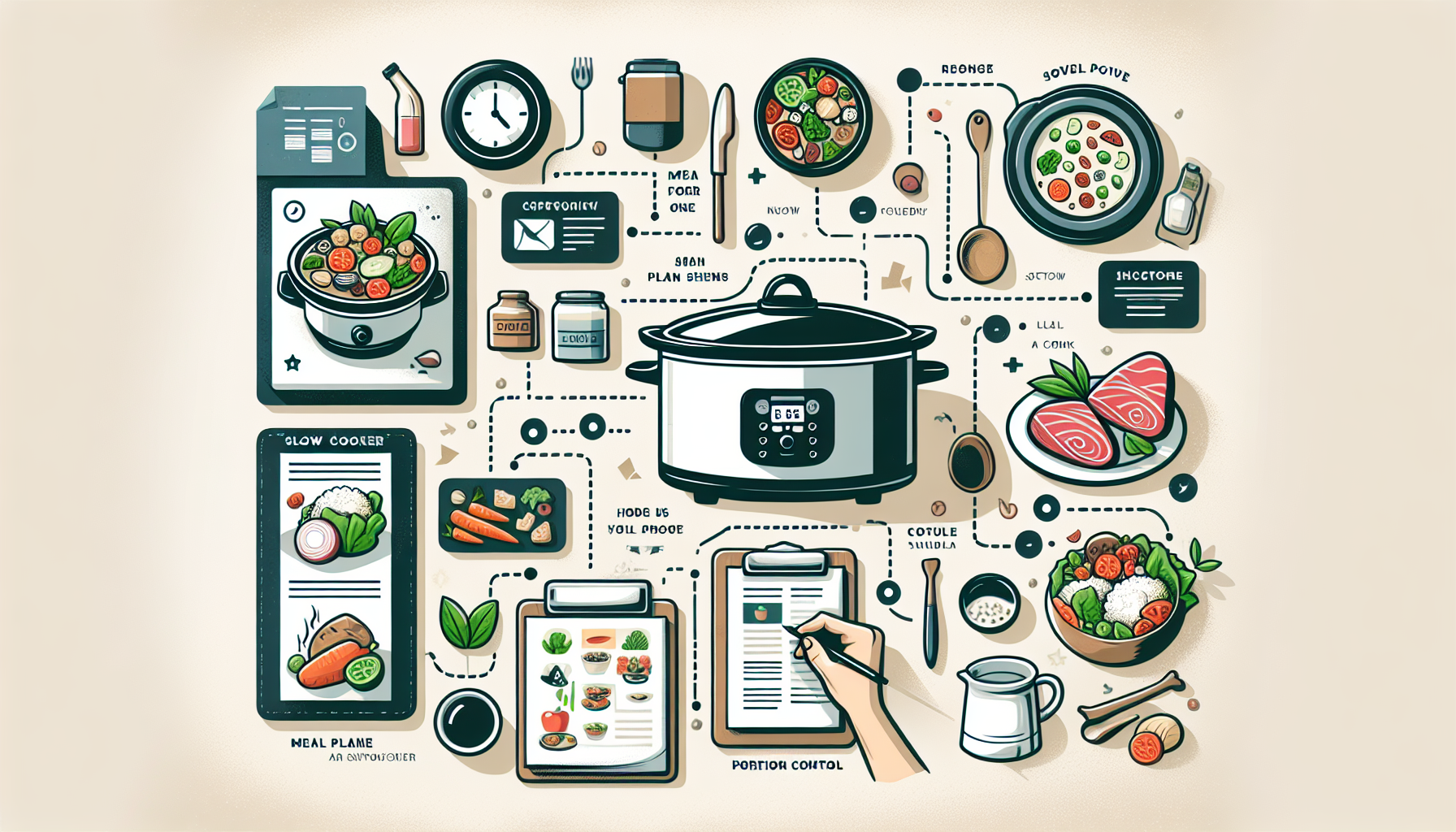If you’re tired of putting in too much effort to cook meals for just yourself, a slow cooker might just be the answer you’ve been looking for. This article will show you how you can make the most out of your slow cooker when cooking for one. With easy-to-follow tips and recipes, you’ll discover the convenience and efficiency of using a slow cooker to prepare delicious and satisfying meals that will keep you well-fed without all the fuss. So, grab your slow cooker, and let’s get cooking!

Choosing the Right Size Slow Cooker
Consider the serving size
When choosing a slow cooker for solo cooking, it’s important to consider the serving size you typically need. Slow cookers come in a variety of sizes, ranging from one quart to eight quarts or more. If you tend to cook smaller portions, a smaller slow cooker will suffice, whereas if you like to batch cook or entertain guests occasionally, a larger size may be more suitable.
Assess your storage space
Another factor to consider when selecting a slow cooker is the amount of storage space you have available. Slow cookers can take up quite a bit of room in your kitchen, so it’s essential to choose a size that fits comfortably in your cupboards or on your countertop. If space is limited, you may want to opt for a smaller-sized slow cooker that can easily be stored when not in use.
Evaluate your cooking needs
Before making your final decision, take a moment to evaluate your cooking needs. Are you looking to prepare simple, one-pot meals, or do you prefer more complex recipes that require additional cooking features? Understanding your cooking style will help you determine which slow cooker features are most important to you.
Opt for a programmable slow cooker
When cooking solo, time management becomes even more crucial. Investing in a programmable slow cooker can be a game-changer for your solo cooking adventures. These slow cookers allow you to set the cooking time and temperature in advance, ensuring your meal is ready exactly when you want it. This feature is particularly beneficial if you have a busy schedule or want to come home to a hot, delicious meal after a long day.
Selecting the Best Slow Cooker Features
Temperature settings
Having adjustable temperature settings on your slow cooker allows you to have more control over the cooking process. Different recipes require varying temperatures, so being able to choose between low, medium, and high heat settings is essential in achieving the desired results.
Timer function
A timer function is another convenient feature that allows you to set the cooking time for your meal. With this feature, you can start your slow cooker in the morning and have it automatically switch to “keep warm” mode once the cooking time is complete. This ensures your food stays warm and ready to eat whenever you’re ready.
Automatic keep warm
An automatic keep warm function is another must-have feature for solo cooking. It ensures that your meal stays warm and ready to eat, even if you’re running late or get caught up in other activities. This feature is especially useful if you have an unpredictable schedule and need the flexibility of enjoying your meal at different times.
Searing function
Some slow cookers come with a searing function that allows you to brown your ingredients before slow cooking. This feature adds an extra layer of flavor and helps to develop a golden crust on meats or vegetables. If you enjoy the depth of flavor that browning can bring to your dishes, consider choosing a slow cooker with a searing function.
Removable insert for easy cleaning
Cleaning up after cooking can sometimes be a hassle, but having a slow cooker with a removable insert can make the process much easier. A removable insert allows you to take out the cooking pot and clean it separately, either by hand or in the dishwasher. This feature saves you time and effort, making solo cooking even more convenient.
Planning Ahead for Solo Slow Cooking
Meal planning and prepping
Meal planning and prepping are essential when it comes to solo slow cooking. Taking some time to plan your meals for the week and prep your ingredients in advance will make your cooking process smoother and more efficient. You can chop vegetables, portion out ingredients, and marinate meats ahead of time, ensuring that everything is ready to go when it’s time to cook.
Choosing the right recipes
When cooking solo, it’s important to choose recipes that easily adapt to slow cooking and suit your preferences. Look for recipes that have longer cooking times or can be left unattended for several hours. Soups, stews, casseroles, and braised dishes are excellent choices for slow cooking, as they develop rich flavors over time.
Adapting recipes for slow cooking
Not all recipes are suited for slow cooking, but that doesn’t mean you can’t adapt them. For recipes that require shorter cooking times or stovetop cooking, you can often modify them to work in a slow cooker. Adjusting the liquid content, cooking time, and temperature can help you achieve similar results without constantly monitoring the stovetop.
Freezing leftovers for future meals
Solo cooking often results in leftovers, but that doesn’t mean they have to go to waste. Take advantage of your slow cooker’s versatility by freezing individual portions of leftover meals. This allows you to have convenient homemade meals ready to enjoy whenever you’re short on time or don’t feel like cooking.
Utilizing Time and Energy-saving Tips
Choose slow cooker-friendly ingredients
When planning your meals for solo slow cooking, choose ingredients that are well-suited for the slow cooker. Tough cuts of meat, root vegetables, beans, and grains all work beautifully in a slow cooker, as the slow, gentle cooking process helps to tenderize them and develop rich flavors.
Prep ingredients the night before
Make use of your evenings by prepping ingredients for your slow cooker meals the night before. Chop vegetables, trim meat, and measure out spices and seasonings. By doing this, you’ll save time in the morning and be able to quickly assemble your slow cooker meal before heading out for the day.
Utilize slow cooker liners for easy cleanup
One of the greatest advantages of slow cooking is the easy cleanup. To make clean-up even more effortless, consider using slow cooker liners. These disposable liners fit inside your slow cooker and prevent food from sticking to the sides, making cleaning up a breeze. Simply remove the liner and dispose of it, and your slow cooker is ready to use again.
Avoid peeking and opening the lid
While it’s tempting to check on your meal and see how it’s progressing, it’s essential to resist the urge to peek and open the lid frequently. Each time you open the lid, heat and moisture escape, extending the cooking time and potentially resulting in unevenly cooked food.
Make use of delayed cooking feature
If you have a programmable slow cooker, take advantage of the delayed cooking feature. This allows you to prep your ingredients the night before, set the desired cooking time, and have your meal ready when you wake up or arrive home. It’s a fantastic time-saving feature that ensures your meal is cooked to perfection when you’re ready to enjoy it.

Maximizing Flavor and Texture
Layer ingredients properly
When using a slow cooker, it’s important to layer your ingredients properly to ensure even cooking and optimal flavor. Start by placing sturdy vegetables at the bottom, followed by proteins such as meat or poultry, and top it off with more delicate ingredients like herbs or leafy greens. This layering technique will help prevent overcooking or undercooking and maximize the flavors in your dish.
Utilize browning techniques
To enhance the flavor and texture of your slow-cooked meals, consider utilizing browning techniques before adding the ingredients to your slow cooker. This can involve quickly searing meat or vegetables on the stovetop to develop a caramelized crust or broiling them in the oven for a few minutes. Browning adds depth and richness to your dishes, creating a more complex flavor profile.
Use spices and seasonings effectively
Spices and seasonings are powerful tools when it comes to slow cooking. Take the time to experiment with different combinations and find your preferred flavor profiles. Remember that the slow cooking process tends to intensify the flavors, so start with a little less seasoning than you would for stovetop cooking and adjust as needed.
Stir sparingly and avoid overmixing
While stirring is necessary for some recipes, it’s best to stir sparingly when using a slow cooker. The gentle heat and long cooking time allow the flavors to meld together, and excessive stirring can disrupt this process. Only stir when the recipe specifically calls for it or when adding delicate ingredients near the end of the cooking time.
Enhance flavors with finishing touches
Don’t forget about the finishing touches to elevate the flavors of your slow-cooked meals. Adding a splash of citrus juice, a drizzle of high-quality olive oil, a sprinkle of fresh herbs, or a dollop of sour cream or yogurt right before serving can bring brightness and complexity to your dish.
Adapting Recipes and Adjusting Cooking Times
Understanding slow cooker cooking times
One of the key factors in successful slow cooking is understanding the cooking times. Slow cookers operate at a lower temperature than stovetops or ovens, which means that recipes often need to be adjusted. Generally, recipes that call for several hours of stovetop or oven cooking can be translated to 8-10 hours on low or 4-6 hours on high in a slow cooker.
Modify recipes for the slow cooker
Not all recipes can be directly transferred to a slow cooker, but most can be modified to work effectively. For recipes that require browning or sautéing at the beginning, you can do this step separately before transferring the ingredients to the slow cooker. Additionally, reducing the liquid by about one-third can compensate for the slow cooker’s sealed environment.
Adjust cooking times for solo portions
When cooking solo, it’s essential to adjust cooking times to avoid overcooking smaller portions. Recipes that are designed to serve a family or a larger group often take longer to cook. Consider reducing the cooking time by 10-15% when preparing solo portions to prevent your meal from becoming mushy or overdone.
Experiment with different ingredients
One of the joys of slow cooking is its versatility, so don’t be afraid to experiment with different ingredients. Whether it’s trying new types of meat, incorporating unique vegetables, or experimenting with spices and seasonings, the slow cooker provides an excellent opportunity for culinary exploration. Let your creativity shine and discover new flavors and combinations that suit your solo cooking preferences.
Avoiding Common Mistakes
Adding dairy too early
Dairy products such as milk, cream, or cheese are best added towards the end of the cooking process in a slow cooker. Adding them too early can cause them to curdle or separate, affecting the texture and consistency of your dish. Follow recipes that specify when to add dairy ingredients or wait until the last hour or so of cooking to incorporate them.
Overfilling the slow cooker
While it may be tempting to fill your slow cooker to the brim, it’s important to avoid overfilling it. To ensure even cooking and prevent spills, aim to fill the slow cooker no more than two-thirds full. This provides ample space for the ingredients to simmer and allows room for the food to expand as it cooks.
Using high heat unnecessarily
Slow cookers are designed to cook food slowly and gently, so there’s often no need to use the high heat setting unless specified in the recipe. Using high heat unnecessarily can result in overcooked or dried out meals, so stick to the recommended temperature settings unless otherwise instructed.
Neglecting to trim excess fat
When cooking meats in a slow cooker, it’s important to trim excess fat before placing them in the pot. Slow cooking will not render fat as effectively as other cooking methods, and leaving it intact can result in greasy and unappetizing dishes. Removing excess fat ensures that your meals are healthier and more enjoyable.
Not adjusting seasoning adequately
The slow cooking process tends to mellow flavors, so it’s important to season your meals adequately. Taste and adjust the seasoning toward the end of the cooking time, adding more salt, herbs, or spices as needed. Remember that it’s easier to add seasoning gradually than to fix an underseasoned dish at the end.
Safety Tips for Solo Slow Cooking
Ensure proper food handling and storage
When cooking solo, it’s important to prioritize food safety. Ensure that all ingredients are fresh and properly stored before using them. Follow proper hygiene practices, such as washing your hands thoroughly, keeping countertops clean, and avoiding cross-contamination. Additionally, promptly store any leftovers in airtight containers and refrigerate them within two hours to prevent bacterial growth.
Monitor and control cooking temperatures
As with any cooking method, it’s crucial to monitor and control cooking temperatures when using a slow cooker. Follow recipe instructions for cooking times and temperature settings, and use a food thermometer to ensure internal temperatures reach safe levels. This is particularly important when cooking meats or poultry to avoid the risk of foodborne illnesses.
Use caution when handling hot slow cooker
Slow cookers can get very hot during the cooking process, so it’s important to use caution when handling them. Always use oven mitts or pot holders to protect your hands when touching the slow cooker or removing the lid. Place the slow cooker on a heat-resistant surface to avoid damage to countertops or other surfaces.
Properly clean and maintain your slow cooker
Keeping your slow cooker clean and well-maintained is essential for its longevity and performance. Always unplug the slow cooker and allow it to cool completely before cleaning. The removable insert, lid, and other components can typically be washed with warm, soapy water or placed in the dishwasher if dishwasher-safe. Regularly check the manufacturer’s instructions for specific cleaning recommendations.
Creating Variety in Solo Slow Cooking
Batch cooking and freezing portions
Creating variety in solo slow cooking can be easily achieved through batch cooking and freezing portions. Prepare larger quantities of your favorite slow cooker meals and portion them out into individual servings. Label and freeze these portions, allowing you to enjoy a variety of meals without the hassle of cooking from scratch every time.
Experimenting with different cuisines
Solo slow cooking is an excellent opportunity to explore different cuisines and flavors. Try recipes inspired by various cultures, such as Mexican, Italian, Indian, or Asian. Slow cooking allows the flavors to develop and meld together, resulting in delicious, authentic-tasting dishes that you can enjoy from the comfort of your own home.
Trying out slow cooker desserts
While slow cookers are commonly associated with savory meals, they can also be used to create delectable desserts. From warm fruit crisps and bread puddings to rich chocolate cakes and creamy cheesecakes, the slow cooker opens up a world of dessert possibilities. Experiment with different sweet treats to satisfy your craving for something indulgent.
Exploring vegetarian and vegan options
Even if you’re not a vegetarian or vegan, incorporating plant-based meals into your solo slow cooking repertoire can be a healthy and delicious choice. Slow cooking is perfect for cooking legumes, grains, and vegetables, allowing you to explore a wide range of meatless recipes that are packed with flavor and nutrition. Try dishes like lentil chili, vegetable curries, or hearty bean stews for a change of pace.
Making the Most of Leftovers
Repurposing leftovers creatively
When you find yourself with leftovers, get creative and repurpose them into new and exciting meals. Leftover roasted chicken can be turned into chicken tacos or added to salads or soups. Cooked vegetables can be blended into a creamy soup or used as filling for savory hand pies. The options are endless, so let your imagination and taste buds guide you.
Creating new dishes with leftover ingredients
Don’t limit yourself to simply reheating leftovers. Take the opportunity to transform them into entirely new dishes. Leftover pasta can be turned into a delicious frittata or added to a stir-fry. Cooked meats can be shredded and used in sandwiches, quesadillas, or even pizza toppings. By adding a few fresh ingredients and some creativity, you can breathe new life into your leftovers.
Freezing and storing leftover meals
If you’re not in the mood to eat your leftovers right away, freezing them is a great option. Portion out your leftover meals into individual containers or freezer bags and label them with the contents and date. This way, you can have a variety of homemade meals available at your convenience. Just remember to thaw and heat them properly before enjoying.
Planning meals using leftover components
When planning your meals for the week, consider how you can utilize leftover components from previous meals. For example, if you roast a whole chicken, plan to use the leftover meat in sandwiches or salads later in the week. This eliminates waste and ensures that you make the most of your ingredients.
By following these tips, you can make the most of your solo slow cooking adventures. Whether you’re a beginner or an experienced cook, a slow cooker is a fantastic tool for creating delicious, convenient meals that suit your individual needs and tastes. So go ahead, embrace the joy of solo cooking, and let your slow cooker become your trusted culinary companion. Happy cooking!
